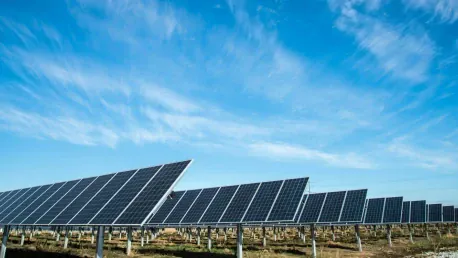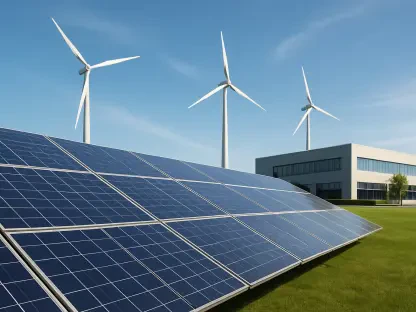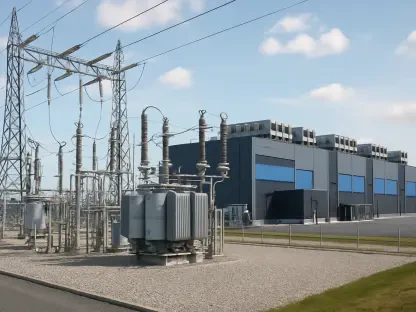Amid a landscape marked by growing electricity demand and evolving regulatory requirements, Kentucky’s leading utilities have made a significant decision: to delay the addition of new solar power capacity until 2035. Despite a clear trend toward renewable energy nationwide, Louisville Gas and Electric (LG&E) and Kentucky Utilities (KU) have outlined a cautious plan to prioritize other energy sources for the next decade. This deliberative approach raises several questions about the future of energy in a coal-dependent state experiencing rapid technological and economic growth.
Rising Demand from Data Centers and Economic Growth
Kentucky’s electricity grid is poised for substantial load growth due to the anticipated expansion of data centers and other economic developments. LG&E and KU’s latest Integrated Resource Plan (IRP) predicts a significant increase in system load, estimated to rise by 30% to 45% by 2032. This surge stems largely from the anticipated expansion of data centers, which are highly energy-intensive, and other economic developments in the state.
Data centers have become critical components of Kentucky’s economic landscape. These facilities operate around the clock, requiring a constant and reliable supply of electricity. Tech giants are prioritizing Kentucky for their operations due to favorable regulatory conditions and a central location, further driving the demand for electricity. As the state’s economy diversifies and attracts more technology-driven businesses, the need for strategic planning in energy generation to meet future demand while ensuring grid reliability becomes even more pressing.
Energy Efficiency and Customer-Installed Solar
Even amidst rising demand, LG&E and KU are counting on energy efficiency measures and increased customer-installed solar to mitigate some of the load growth in Kentucky’s energy landscape. The utilities forecast that these initiatives will reduce overall load by more than 3.5% by 2032. Energy efficiency programs include everything from residential and commercial efficiency upgrades to more sophisticated demand-response initiatives aimed at optimizing electricity usage during peak times.
Customer-installed solar has also been identified as a key factor in lowering future electricity demand. Kentucky residents and businesses are increasingly investing in their own solar installations, driven by both environmental concerns and potential cost savings. These individual efforts contribute cumulatively, decreasing the pressure on the central grid and reshaping the energy consumption landscape. By promoting customer-installed solar, LG&E and KU can leverage distributed energy resources to alleviate some of the demand stresses on the grid, even as larger-scale solar projects are delayed.
Phased Introduction of New Generation Capacity
In their IRP, LG&E and KU outline a phased approach to introducing new generation capacity that prioritizes natural gas and battery energy storage. The initial focus will be on installing two natural gas combined-cycle units in 2030 and 2031. These units are intended to provide reliable, dispatchable power that can be called upon as needed, supporting the grid’s stability as renewable resources continue to evolve.
In addition to natural gas, LG&E and KU plan to bring 400 MW of battery storage online by 2028. This will be followed by another 500 MW of storage and 500 MW of solar PV in 2035. The focus on natural gas and battery storage reflects a strategic choice to prioritize reliable, dispatchable power sources. These technologies are seen as critical to maintaining grid reliability and affordability, especially as the proportion of intermittent renewable energy sources increases.
The Enhanced Solar Plan
While the primary IRP schedule delays significant solar installations until 2035, LG&E and KU have an alternative “enhanced solar plan.” This plan is designed to accelerate the adoption of solar capacity if certain conditions, such as customer demand or economic viability, favorably change. Under this more aggressive scenario, 200 MW of solar capacity would be installed by 2028, another 200 MW by 2030, and an additional 600 MW by 2032.
The enhanced plan underscores the utilities’ readiness to adapt to shifting market dynamics. Should solar power become more economically competitive or if customer-driven demand for renewable energy intensifies, LG&E and KU could pivot faster towards solar, shortening the timeline for integrating substantial solar energy into their portfolios. This flexibility allows the utilities to respond to changing conditions, ensuring that their energy mix aligns with both economic realities and customer preferences.
Economic Competitiveness of Solar Energy
At the heart of the delay in new solar capacity is the economic competitiveness of solar energy. LG&E and KU remain cautious about the current economic feasibility of solar compared to other forms of generation. The utilities stress that only a significant reduction in solar costs would prompt a more rapid adoption.
Solar technology costs have been falling over the past decade, but for LG&E and KU, the pace of cost reduction is not yet compelling enough to warrant immediate, large-scale investment. The decision to wait until 2035 hinges on the belief that future technological advancements and market conditions will make solar a more viable economic choice by that time. As costs continue to decline and efficiencies improve, the likelihood of earlier solar adoption becomes more plausible.
Customer Demand and Market Pressures
Customer demand, particularly from data centers with strict carbon reduction goals, could influence LG&E and KU’s solar adoption timeline significantly. These tech-driven infrastructures aim to meet their corporate environmental commitments by sourcing a substantial portion of their electricity from renewable sources, which could create increased pressure for the utilities to speed up their renewable energy plans.
Market pressures from environmentally conscious consumers and businesses are considerable. Companies moving into Kentucky may have internal mandates to source a significant portion of their electricity from renewable sources, leading to increased demands on LG&E and KU to expedite the enhanced solar plan or initiate additional renewable projects. The growing emphasis on sustainability and carbon reduction goals among businesses further underscores the need for utilities to consider more aggressive timelines for renewable energy adoption.
Regulatory Landscape and Historical Dependency on Coal
Any strategic decisions made by LG&E and KU are heavily influenced by Kentucky’s regulatory environment and historical reliance on coal. The state has long been dependent on coal-fired power generation, which creates entrenched interests and regulatory frameworks that favor traditional energy sources. Kentucky’s regulatory landscape, including Senate Bill 4, restricts the retirement of fossil fuel plants, mandating that utilities demonstrate grid reliability and customer affordability will not be negatively impacted before proceeding.
This regulatory environment complicates the transition to renewable energy, requiring utilities like LG&E and KU to balance economic, operational, and regulatory considerations. The historical dependency on coal has shaped the utilities’ strategic planning, making the cautious approach to solar capacity more understandable. Shifting away from coal to a diversified energy portfolio that includes significant amounts of renewable energy involves navigating complex regulatory landscapes and ensuring that grid reliability and affordability are not compromised.
Conclusion
In the face of increasing electricity demand and shifting regulatory landscapes, Kentucky’s top utility companies have chosen to delay the introduction of new solar power capacity until 2035. Louisville Gas and Electric (LG&E) and Kentucky Utilities (KU), both major players in the state’s energy sector, have decided to take a conservative stance by focusing on other energy sources over the next decade. This cautious strategy is notable, given the nationwide push toward renewable energy and the urgency of addressing climate change.
Kentucky is a state traditionally reliant on coal, yet it’s also seeing swift advancements in technology and economic growth. These dynamics add layers of complexity to the utilities’ decision. Many might wonder whether this delay will impede the state’s ability to meet future energy demands sustainably. Additionally, questions arise about the economic and environmental implications for the region, especially as other states and countries forge ahead with ambitious renewable energy goals.
This decision by LG&E and KU highlights the tension between maintaining traditional energy sources and innovating for a greener future. It underscores the importance of a balanced approach in a state where coal has historically played a central role in its economy and energy production. The coming years will be pivotal in determining how Kentucky navigates this landscape, balancing economic growth, energy demands, and environmental responsibilities.









